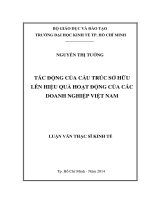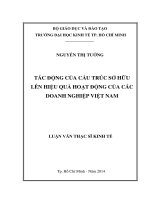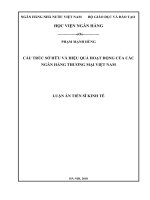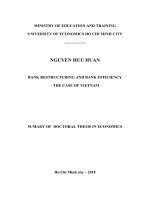Tái cấu trúc ngân hàng và hiệu quả hoạt động ngân hàng trường hợp việt nam nơi nghiên cứu đại học kinh tế TPHCM tt tiếng anh
Bạn đang xem bản rút gọn của tài liệu. Xem và tải ngay bản đầy đủ của tài liệu tại đây (172.8 KB, 22 trang )
MINISTRY OF EDUCATION AND TRAINING
UNIVERSITY OF ECONOMICS HO CHI MINH CITY
--------------
NGUYEN HUU HUAN
BANK RESTRUCTURING AND BANK EFFICIENCY
- THE CASE OF VIETNAM
SUMARY OF DOCTORAL THESIS IN ECONOMICS
Ho Chi Minh city – 2018
The Thesis was completed in:
.........................................................................................................
.........................................................................................................
.........................................................................................................
.........................................................................................................
Scientific guide:
.........................................................................................................
.........................................................................................................
.........................................................................................................
.........................................................................................................
Reviewer 1:
.........................................................................................................
.........................................................................................................
.........................................................................................................
Reviewer 2:
.........................................................................................................
.........................................................................................................
.........................................................................................................
Reviewer 3:
.........................................................................................................
.........................................................................................................
.........................................................................................................
The thesis will be protected by the Board of Review in:
.........................................................................................................
.........................................................................................................
.........................................................................................................
At....................................................................................................
The thesis can be found at the library:
.........................................................................................................
.........................................................................................................
.........................................................................................................
.........................................................................................................
.........................................................................................................
TABLE OF RESEARCH PAPERS
Vo, X. V., & Nguyen, H. H. (2018). Bank restructuring and bank
efficiency—The case of Vietnam. Cogent Economics &
Finance, 6(1),
1520423.
/>Vo, X. V., & Nguyen, H. H. (2015). Does Bank Restructure Lead to
Higher Efficiency? An Investigation of the Vietnamese Banking
System, Singapore Economics Review, Namyang University,
Singapore.
Vo, X. V., & Nguyen, H. H. (2015). The impact of restructuring on
structure and performance – Evidence from Vietnam, Infiniti
Conferrence, University of Sydney, Australia.
SUMMARY OF THESIS
Chapter 1. Introduction
In this chapter, the author presents the role of banking system and
introduces the performance of Vietnamese banking system from
2008 until now; details the motivations, research questions and
objectives. In general, under the effect of the global financial crisis,
Vietnamese banking system has coped up with many difficulties and
challenges to improve the operational efficiency of the entire system
and individual banks. With the aim of assessing the situation to
restructure the banking system in Vietnam in recent years, the subject
which is made is based on previous studies on restructuring the
banking system. The thesis focuses on the study of the restructuring
process of the Vietnamese banking system from 2007 to 2015, in
conjunction assesses different financial structure of the system before
and during the implementation stage in the restructuring. More
specifically, it examines how the restructuring measures effect on the
performance of the commercial banks and whether the process of
restructuring in the sample period increases the operational
efficiency of the banks or not. It also explores the effect of reform on
Vietnam’s bank structure and performance.
The first research question is based on a research gap that there
hasn’t been any study discovering the influence of bank restructuring
method on bank restructuring process in a small transition economy,
especially Vietnam. It is stated as “How the restructuring measures
were introduced as government intervention, merger and acquisition
of commercial banks and privatization of state-owned commercial
1
banks effect on the performance of the commercial banks in the study
period of Vietnam?”. To resolve this question, the following
hypothesis is tested:
H1.1:
Government
intervention
increases
the
effective
of
commercial banks' performance.
H1.2: Merger and acquisition increases the effective of commercial
banks' performance.
H1.3: Privatization of state-owned commercial banks increases the
effective of commercial banks' performance.
The second research question examines the effects of first-stage
reform on bank structure and performance in Vietnam. It is stated
that “What are the effects of reform on Vietnam's commercial bank
structure and performance?” With this research question, it is a
development of classic hypotheses in restructuring, such as quiet-life
hypothesis, market power and efficiency structure hypotheses to
analyze changes in bank performance and structure before and
during restructuring. And to address this objective, the following
hypothesis is tested:
H2.1: The collusive behaviour of dominating firms in the industry
influences the price setting process in the market which allowes
those firms to gain superior profit over other firms. The relationship
between market concentration and firm performance is positive.
H2.2: Firms with relatively bigger market shares and differentiated
product lines have a superior market power and use it to set market
price and, thereby, earn an above average profit. Accordingly, the
2
market share and the firm’s performance might have a positive
relationship.
H2.3: This hypothesis is based on ES theory: low costs of production
by relatively efficient firms enable them to compete more
aggressively, capture a bigger market share and earn higher profits.
H2.4: Quiet-life hypothesis: Banks that have higher market share
have lower efficiency.
3
Chapter 2. Literature review
Chapter 2 reviews the previous literature on restructuring
including the literature relating to factor impacting to bank
efficiency; the theoretical issues and literature pertaining to bank
restructuring and bank efficiency; and the previous literature on
method of bank restructuring. Besides, this chapter discusses the
theoretical background and the prior literature on the relative
between bank restructure and bank efficiency and the effect of bank
reform on bank structure and performance.
First is background knowledge about restructuring. In this
content, the author presents Efficiency theory; the related hypothesis
includes Market structure and performance hypothesis, Relative
market power hypothesis, Quite-life hypothesis; and literatures
involving.
Second, the literature review focuses on method of bank
restructuring and bank efficiency. It discusses the relationship
between bank restructuring and bank efficiency; and then the bank
restructuring methods and its effect on bank efficiency.
Third is the literature review about the structure and
performance relationship in banking system. In a large amount of
literature, the author used three main hypothesizes about the structure
and performance relationship in banking which is the market power
hypothesis and the other is the efficiency structure hypothesis.
4
Chapter 3. Data and methodology
Chapter 3 presents the sample data and methodology used to
test the hypotheses related to the three research questions. It
describes the data sources, the data characteristics, and the necessary
to separate revolving from term loans, the sampling selection
process, model specifications, estimation methods, and the
robustness tests to confirm the main findings.
Data and sample
In this thesis, the data in 26 banks’ financial statements were
collected from Bankscope covering the period from 2001 to 2015.
The sample includes banks which are influenced by the banking
crisis in 2008 then implement restructure. Annual data are used to
measure technical efficiencies. Unconsolidated financial data
obtained from the Bankscope database focus on analysing the
changes in banks’ operations during the implementation period of
pre, during restructuring.
Methodology
This content describes the estimation methods for RQ1 (Data
Envelopment Analysis) and RQ2 (Data Envelopment Analysis and
Generalized Least Squares). For RQ1, the author applies DEA 3
steps to calculate how dependent variables were affected by
environment variables. For RQ2, instead of investigating the impact
of environment variables, the author uses normal DEA for step 1 to
solve them.
5
Variables and descriptive statistics
This content presents the variables and descriptive statistics
variables employed in this thesis. Firstly, for the bank efficiency
from the restructuring methods, three inputs and three outputs under
the intermediation approach are specified productivity model. The
first group of independent variables using to test the impact of
restructuring measures on bank efficiency include dummy variables
for domestic bank mergers (MER), privatization (COP), and state
intervention (SI). Besides, there are the control variables include six
country specific factors variable and the control variables include six
country specific factors and bank characteristic.
Secondly, to carry out models for RQ2, the author collects and
calculates all of these following variables in this table:
No.
1
2
3
4
5
6
7
8
9
10
11
12
13
Variable
ROA
ROE
The four-bank concentration
ratio
The Herfin- dahl-Hirschman
Index
Market share
X-efficiency
XINEFF
Ownership dummy
Time trend
The ratio of loans to assets
The ratio of equities to assets
SCALE
SINEFF
6
Abr.
ROA
ROE
CR4
HERF
MS
XEFF
XINEFF
OWN
TT
LA
KA
SEFF
SINEFF
Model
RQ1: The effect of restructuring methods on banking
performance
The three-step model
In this research question, three inputs and three outputs are
used in stage 1. It is suggested that the role of a bank is to mobilize
funds at the lowest cost; we include deposits (TD), interest expense
(IE) and non-interest expense (NE) as the input variables. Three bank
outputs capturing both traditional and non-traditional activities of
banks consist of total loans (TL), Interest revenue (IR) and Noninterest revenue (NR).
Environmental variables in step 2
To discover the impact of environmental factors on the validity
of the initial efficiency analysis, three bank restructuring measures,
six country-specific factors are included in step 2.
In step 2, we carry out the test by following models:
= (1)
= (2)
= (3)
=(4)
= (5)
7
= (6)
After calculating the effect of three restructure method to three
inputs: total deposits (TD), interest expense (IE) and non-interest
expense (NE) and three outputs: total loans (TL), interest revenue
(IR) and non-interest revenue (NR), we continue calculating three
inputs and three outputs under effect of six countries specific in table
3.9. And we build six equals following to measure the impact of
these control variables to input and output variables:
= (7)
= (8)
= (9)
= (10)
= (11)
= (12)
Finally, step 3 is similar to stage 1 using DEA method but
replaces three inputs and three outputs adjusted in step 2.
RQ2: The effects of reform to structure and performance
Thesis’s ideas based on love study of Berg (1995) and Fu
(2009) to test the hypothesis Quiet - life and efficient structure for
the period of restructuring the system. By testing out the QLH, thesis
can show out that whether the restructuring have direction effective
to structure the system or not and how much the impact level is.
8
First, according to Berger (1995) and Goldberg and Rai
(1996), Eq. (1) is used to test the validity of the hypotheses:
+ eit (1)
Where : a measure of profitability, such as return on assets
(ROA), of bank i at time t; : a measure of market concentration, such
as four-bank concentration ratio (CR4) or Herfindahl–Hirschman
index (HERF) of concentration at time t; : market share (in terms of
deposits) of bank i at time t; XEFF it: X-efficiency of bank i at time t;
SEFFit: scale-efficiency of bank i at time t; e it: a vector of control
variables.
Under the efficient-structure (ES) hypotheses, causation is
assumed to run from efficiency to profits, and to market structure.
More efficient banks should have higher profits, so the signs of the
coefficients on XEFF and SEFF should be significantly positive, that
is, > 0, > 0. Under the market-power hypotheses, a positive and
significant b1 confirms the structure-conduct-performance; should
be positive if the relative market-power hypothesis holds.
It is possible that the measures of concentration (CONC) and
market share (MS) are endogenous in the ES model. However,
Berger (1995) argued they can be included as independent variables,
since they are correlated with profitability only because they reflect
the influences of XEFF and SEFF and/or the control variables in Eq
(1).
To ensure the absence of a spurious relationship between
profitability and market structure, both profits and the market
9
structure variables must be positively related to efficiency. Thus, a
necessary condition for the efficient-structure hypothesis to hold is
that efficiency has a positive effect on market structure. To establish
its presence, two additional equations are estimated:
(2)
+ + eit (3)
Like Berger and Hannan (1997), Eqs. (4) and (5) are used to
test Hicks’ (1935) ‘quiet life’ hypothesis.
XEFFit= a + CONt +MSit +CONTROLit + eit (4)
SEFFit = a + CONCit + MS + CONTROLit + eit (5)
According to the ‘quiet life’ hypothesis, the signs on the
coefficients on CONC and/or MS should be significantly negative in
Eqs. (4) and (5). Thus, banks with greater market power are less
efficient due to a relaxed environment and slack management. Note
the direction of causation is reversed between Eqs. (2)/(3) and (4)/
(5). If both sets of relations are found to hold, then OLS estimation
causes simultaneous equation bias (Berger and Hannan, 1997), which
is usually resolved by using a two-stage least squares (2SLS)
procedure.
Roburstness test
This content discusses the robustness tests used to address
methodology concerns related to the different proxies for measures
of restructuring method’s effects on the performance and efficiency
10
of the commercial banks. They are SFA regression for research
question 1 and SFA and and Hausman test for research question 2.
11
Chapter 4. Results and discussion of results
The empirical results for the hypothesis testing of the three research
questions are reported in Chapter 4.
Result of Research question 1
The thesis examines the impact of the measures that the government
put forward which are the government intervention, M&As and
privatization of state-owned commercial banks. The study results
show that M&As increase both the input and the output of
commercial banks. During the post-restructuring period, it appears to
be less in Managing Resources to Produce Efficient output because
the banking takeover has merged to bear inefficiency of weak banks
as credit and liquidity risk. Thus, banks that have support from the
government, usually through recapitalization have to face higher
marginal costs to generate revenue and higher inefficiency. This is
quite consistent with the reality in Vietnam where banks that receive
the government’s support from mostly state-owned commercial
banks, and in return, they often have to spend higher expenses for
activities to support the government and the community.
Besides, privatized banks do not seem to greatly affect the
performance of the commercial banks because the central bank still
holds dominant shares of the Commercial Bank, which does not have
a significant change on the structure and the operation of the
machine.
Result of Research question 2
From the test results, it can be concluded that the effects of reform on
Vietnam's commercial bank structure and performance as follows:
12
In the research period, both stage 1 and stage 2, RMP theory is hold
and nothing change the structure in banking system between two
states. With four state-owned banks, there was no evidence of a
significantly negative relationship between the concentration and the
efficiency. It means that in the bank restructuring period in Vietnam,
banks with higher market share were more profitable and
independent of market concentration (RMP). In the first stage, there
is a great impact and influence of big-four state-owned commercial
banks. They have advantages to mobilize money from state agencies,
state treasuries ... as well as the favour from the government.
Therefore they create a high market share and bring big profits. At
the second stage, although state-own commercial banks were
privatization, but state-bank still covered the majority shares and the
monopoly still exists. While there is no evidence show that low costs
of production by relatively efficient firms enable them to compete
more aggressively, capture a bigger market share and earn higher
profits as ES theory. In comparison with some previous papers, the
result of this test in the Vietnamese economy is different from the
Chinese one. Ye, Xu and Fang (2012) showed that during the period
of 1998–2007, neither the SCP nor ES hypotheses were held in
China; In the Chinese reform period, only X-Efficiency Hypothesis
was held. There is a difference between them because the banking
restructuring in two countries are different. In Vietnam, the main
factors in restructuring resolve bad debt focus on M&A and
privatization. Meanwhile in China, beside normal restructuring
methods, they strengthen banking administration including
organizational and human resource, banks are also allowed to
increase their capital and use new mobilized capital to increase
investment in technology system and risk management to improve
the efficiency of banking operations.
13
Results
Research questions, related hypotheses
Stage 1
Stage 2
Stage 1
Stage 2
How the restructuring measures
were introduced as government
intervention,
Panel A - RQ1
merger
and
acquisition of commercial banks
and privatization of state-owned
commercial banks effect on the
performance of the commercial
banks in the study period?
H1.1:
Government
increases
the
intervention
effective
Not
of
Supported
commercial banks' performance.
H1.2:
Hypotheses
Merger
increases
the
and
acquisition
effective
Not
of
Supported
commercial banks' performance.
H1.3: Privatization of state-owned
commercial banks increases the
Not
effective of commercial banks'
Supported
performance.
What are the effects of reform on
Panel B – RQ2
Vietnam's
commercial
structure and performance?
14
bank
Stage 1
Stage 2
(2001-
(2007-
2006)
2015)
H2.1: This hypothesis, based on
SCP, suggests that the collusive
behaviour of dominating firms in
the industry influences the price
setting process in the market which
allowed those firms to get high
profit over the other firms. SCP
Insufficien
t
Insufficient
supposes that there is a positive
relationship
concentration
between
market
and
firm
performance.
H2.2:This hypothesis is based on
Hypotheses
RMP. It suggests that Firms have
bigger market shares and welldifferential
products
will
have
Supported
Supported
Not
Not
Supported
Supported
higher market power and can
achieve more profit than usual
firms do.
H2.3: This hypothesis is based on
ES theory: low costs of production
by relatively efficient firms enable
them
to
aggressively,
compete
capture
more
a
bigger
market share and earn higher
profits.
15
H2.4 Quiet life hypothesis. Banks
have higher market share would
Insufficient
Insufficient
have lower efficiency.
Chapter 5. Conclusion
Chapter 5 concludes the thesis.
Review Of Research Questions, Hypotheses And Findings
The table below presents a summary of the thesis’ two research
questions and their 8 associated hypotheses and findings. The
research questions are raised in Chapter 1 and their hypotheses are
developed in Chapter 2. The data and methodology to test these
hypotheses
and
variable
selections
and
measurements
are
documented in Chapters 3. The findings are discussed in Chapter 4.
Contributions
First, the thesis’ contribution is to point out the overall picture of the
restructuring process in Vietnam at early stages. This research
indicates that the first period of banking restructuring in Vietnam was
not effective because the government still hold the majority of
shares, which did not change much the operational structure of the
commercial banks. Besides, banks were strongly affected by the
environment factors. Upon that, a system of solutions for this issue
can be built. This investigation is consistent with prior studies of
Hsiao et al (2010), Thoraneenitiyan (2009) which showed that the
bank efficiency dropped during the restructuring period due to
transitioning cost. Moreover, the bank efficiency was also affected by
the environment variables, such as financial crisis or weak domestic
economy.
16
Second, in the context of the bank restructuring initiated during this
period, the objectives are to identify which model, if any, best
described the competitive structure of Vietnam’s banking sector and
the impact of the bank size/ownership. The results indicate that the
banking system structure changes towards higher profits, higher
efficiency score but the sensitivity and vulnerability also increase.
These activities affected banks from the crisis of the world recession
is higher than the pre-restructuring period. This indicates that in an
open economy such as Vietnam, a side benefit to increase the
competitiveness of the system on the one hand would bring
challenges to domestic banks for further integration into the
international financial system. Comparing with prior studies in China
(Fu and Heffernan, 2009), the economy shares consistent
characteristic with Vietnam: the emerging market, the transitioning
and socialist economy. This investigation shows that Vietnam’s
banking system is more vulnerable and sensitive than China’s
banking system during the transition period; the difference is the
scale as Vietnamese economy’s is quite small. So, this finding shows
the small economy has to face more pressure and instability than big
economy during the transition and the integration process, which is
consistent with the economies of scale theory (Silberston, 1972).
Theoretically, this is the first time that the market-power, the quiet
life and the efficient-structure hypothesisare extended to be included
in the test on the impact of the banking restructuring on the
performance of Vietnam banking system as well as the small open
transition economy, then this gap was filled with this hypothesis.
Implications
Regarding to the effect of restructuring methods, it was shown that
the change of the bank ownership of the state-owned commercial
banks did not have a significant change on the operational structure
of the commercial banks. Additionally, the government should
17
reduce its intervention in the market, actively allow privatization of
state-owned commercial banks as well as maintain integrative
policies to enhance the competition and the transparency of the
banking system.
These results have provided us with a partly comprehensive
restructuring of the banking system in Vietnam as the
implementation process of the restructuring to integrate in the
international financial markets. A major problem arises as the
opportunity to take advantage of is connected with the financial
system to raise capital and capital exchange, but the financial system
in small emerging countries will face an edgy pressure of huge
competition from foreign banks, and the instability of the banking
performance will also increase not only during the global economic
crisis that cover early stages of the integration process. Instead of
accepting such rapid integration, the government needs to build a
strategy and a plan to engage in the international financial system to
ensure the system stability during and after the transitioning period.
Finally, governments should prepare fully and consider
carefully about the right time that they choose to integrate into
international financial markets, avoid integration at the time of
the world financial crisis.
Limitations
Nevertheless, this thesis has some limitations. In terms of its data’
characteristics, the main sources of data used for this thesis were
obtained from Orbis Bank Focus and State Bank of Vietnam. There
were some missing numbers which caused difficulty for the variable
statistics. Besides, the banking restructuring still took place, so the
research could only be carried out with the first stage of the
restructuring in the period from 2007 to 2015. Regarding to the
research method, there were quite a few research methods for this
18
issue but there was no method better than the others and suitable for
all cases. Thus, the methods were combined together properly to
solve the research’s issue.
Future Research Directions
These results have provided an overview of the comprehensive
restructuring of the banking system in Vietnam and the conclusions
are quite similar to the previous studies on emerging markets well as
the implementation process of the restructuring to integrate in the
international financial markets. Whether Vietnamese commercial
banks can maintain the market share, stand out in the market and
benefit the competitive advantage with commercial banks in foreign
countries that have been increasingly involved in the financial
system in a sweeping Vietnam or not, or become trend follower of
another economy, remain small and open with less competitiveness ,
obsolete technology and management skills, lose market share to the
foreign banks, be subject to distribution from them and major
financial institutions of the world.
Besides, the author also intends to investigate why some banks can
overcome the restructuring process and the impact of the world
financial crisis, and continue to develop, while other banks cant do it.
That would be the next research direction for the following topics.
19









